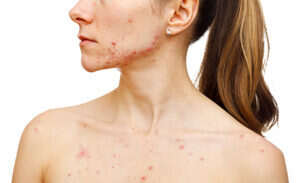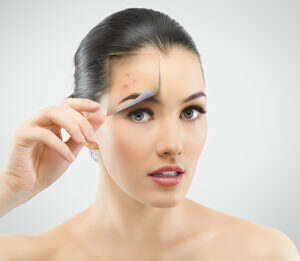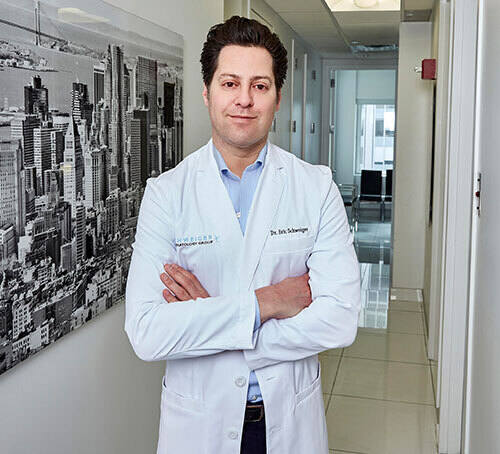Keeping It Clear: Tips and Tricks for Combatting Cystic Acne

Anyone who has ever experienced an inconvenient pimple knows that it’s annoying but eventually goes away pretty fast.
However, there is a big difference between a random breakout and cystic acne. Let’s dig into why cystic acne differs from a regular breakout.
What is Cystic Acne?
Cystic acne often looks like boils on the skin, while common pimples are more likely to appear on the skin’s surface.
Cystic acne develops because a combination of bacteria, dead skin cells, and oil gets trapped deep within your hair follicles. They can appear on the skin’s surface as large pus-filled cysts and produce large red bumps if they rupture.
Cystic acne can also be incredibly painful. While cystic acne mostly appears on the face, it can also appear on the chest and back. Since cystic acne is very severe, treatment with OTC (over-the-counter) topicals will do very little because they are not strong enough.
If you believe you have cystic acne, it is essential to treat it as quickly as possible with a dermatologist. Cystic acne, if left untreated, can lead to severe scarring.
Acne Scarring
Early treatment of cystic acne is essential to avoid acne scarring. All acne scarring occurs when a breakout damages the tissue beneath and around it.
However, the dark marks left behind when you prick a pimple is not an acne scar. That is just discoloration of the surrounding skin, typically fading within a few weeks or months.
Cystic acne scarring is severe and, if left untreated, becomes increasingly difficult to treat.
Depressed scars are the most common, also known as atrophic scars. Depressed scars go deep into the skin and occur when the tissue around the cyst is not healing properly. They can be shallow or deep. They can also look like holes or chickenpox scars.
Avoid picking or popping any cystic lesions to prevent these scars from forming.
How to Treat Cystic Acne
So how do we treat this type of acne compared to a random pimple?
Prescription topical and oral therapies are necessary to start combating the causes of cystic acne. Dermatologists will often combine two treatments depending on the severity.
Oral Antibiotics for Cystic Acne
Oral antibiotics may be used as the first line of treatment for cystic acne. Oral antibiotics work by attempting to decrease the bacteria contributing to the deep cysts and large pus-filled cysts.
The only problem with oral antibiotics is they will not get rid of dead skin cells and excess oil, which are the other culprits. Antibiotics are used short-term, so you do not develop bacterial resistance.
The oral medication spironolactone is also prescribed for women with cystic acne on their lower face or jawline – the area of hormonal breakouts.
It works by managing hormone levels that could contribute to cystic acne. It is a very commonly prescribed medication, but it may cause congenital disabilities, so you should not take this if you are planning to become pregnant.
Isotretinoin for Cystic Acne
If there is no response to oral antibiotics or spironolactone (for women), the most powerful (and considered the most effective) medication for cystic acne is Isotretinoin, formerly Accutane.
It is a potent derivative of Vitamin A in oral form. Over 80% of patients see improvement within six months of beginning Isotretinoin therapy.
However, several side effects can occur. This includes:
- Nosebleeds
- Headaches
- Joint pain
- New or worsening mood disorders
Although rare, if you begin to experience any new or worsening depression, you must notify your dermatologist immediately.
Isotretinoin’s most severe side effect is severe congenital disabilities in pregnant women.
A mandatory prescribing and compliance system called iPledge is necessary to use Isotretinoin. You must be registered into the system and meet the program’s requirements to receive the medication.
Your dermatologist must also be enrolled in this program to be able to prescribe it to you.
Retinoid for Cystic Acne
Topical retinoids (different from retinol) are also a derivative of Vitamin A but are used directly on the skin. While topical retinoids are nowhere as strong as Isotretinoin, they do work to unclog the hair follicles and help break up the cysts to prevent future breakouts.
They can be used daily but may make your skin peel, flake, and become more sensitive to the sun.
A non-comedogenic physical sunscreen must be used to protect your skin. Peeling and flaking are temporary and will disappear as your skin gets used to this product.
Chemical Peels for Cystic Acne

Chemical peels are one of the most common treatment boosters. Chemical peels use gentle acids that help exfoliate the top layers of the skin to help unclog pores and begin to improve deeper scars.
Chemical peels are made of different strengths and penetrate different levels of the skin. Therefore, it is important to ensure that they are performed by a trained professional to avoid further scarring or other complications.
They are often performed in a series of 3-5 monthly treatments.
Lasers for Cystic Acne
Lasers and light-based therapies can also help to improve breakouts and scarring. Light-based treatments, such as Isolaz and Photodynamic Therapy (PDT), work on killing the bacteria that causes the cysts to develop and calming the inflammation of the larger deep cysts.
Lasers are used to resurface the skin and help to improve the appearance of the deep scars. However, laser resurfacing can only be done once an active cystic breakout is cleared.
A series of treatments (often 5) is recommended with both treatments, and improvement happens over time and varies from patient to patient.
Fillers for Acne Scars
Fillers can also be used to fill in very deep scars. PRP, or platelet-rich plasma, is one of the most common fillers for deep scars.
PRP uses an infusion of your body’s growth-factor-rich collagen to repair the wound causing the scar.
A series of treatments is usually recommended, and maintenance treatments are required to maintain the results.
The other popular filler for deep acne scarring is Bellafil®, which comprises ingredients that stimulate your body to produce collagen. Improvement can last five or more years.
Preventing Cystic Acne
The answer to the question, is cystic acne preventable, is both yes and no.
Let’s start with the no. Cystic acne may have a hormonal component to it. Lab tests will need to determine if that is the case.
Cystic acne can also be genetic. If a parent had cystic acne, the likelihood of you developing it is higher. Bottom line: there are some things you cannot control in the development of cystic acne.
Now let’s get a look at the yes. An excellent foundational skincare regimen and lifestyle routine will help reduce some contributing factors that cause cystic acne.
At-Home Care for Cystic Acne
If you are dealing with cystic acne, at-home care will involve your daily facial products.
Washing your face should become an essential part of your routine. If you are developing cystic acne, chances are you have oily skin. It is necessary to wash your face morning and night.
Look for a gentle foaming cleanser that removes dirt and excess oil but doesn’t dry your skin. If you want to take it up a notch, you can add an acid-based cleanser that contains alpha-hydroxy-acids (AHAs) or beta-hydroxy-acids (BHAs).
These cleansers will help to exfoliate your skin and unclog pores. Use them in the morning to clear out any breakout-causing bacteria and dead skin cells that may have been building up overnight.
Less is more when it comes to using acid-based products. You can irritate your skin if you use too much! Avoid harsh exfoliants like mechanical brushes, harsh sponges, and facial scrubs.
Over-exfoliating, your skin is not only super irritating, but it can dry out your skin or make you break out more. It is also important to wash your face and body immediately after working out to remove oil and bacteria buildup.
While this may sound completely counterintuitive, you still need to use a moisturizer. Treatment for cystic acne can dry out your skin and make it flaky.
Stay away from oils and products that contain glycerin. These ingredients can clog up pores.
Instead, use a calming cream formula for sensitive skin or a hyaluronic acid-based moisturizer. This will trap moisture in the skin without creating a breeding ground for breakouts.
Makeup for Cystic Acne
If you wear makeup, select products labeled “oil-free” and “non-comedogenic.” Try and avoid layers of heavy makeup that can clog pores.
If you are looking for full coverage products, look for mineral pigments and hypoallergenic formulas. Those will be gentle on the skin.
Instead of painting on layers, use concealer for more targeted spots. Avoid shimmery powders, which can draw attention to cystic acne by attracting light to your face.
To set your makeup, use a clean brush and swipe on powder. Don’t push it into your skin with the puff that comes in the compact.
Make sure you wash your brushes weekly and use a cleansing spray in between to keep bacteria from growing and transferring to your face.
Two Important Tips for Fighting Acne

Never go to bed with makeup on!
Going to bed with makeup is like a spring break party for bacteria on your face! Think about it- sweat, dirt, oil, products, smog, etc., nestled nicely underneath a layer of makeup for the next 8 hours.
Make sure you take off any makeup with gentle micellar water and your gentle foaming cleanser. Unless you have prescription topicals that you must use at night, it’s just two simple steps, and then bed!
Use Sunscreen
Stress can affect the behavior of your skin. It is one of the major causes of breakouts. Studies have shown that when our bodies are stressed, hormones are released and can bind to receptors in the skin’s sebaceous glands, which drives up the skin’s oil production.
While stress alone isn’t a cause of cystic acne, it can contribute when combined with other factors. Finding mindful moments of meditation or relaxation throughout the day is important.
Yoga and other forms of exercise can also help to reduce stress levels.
Stress and Acne
Stress can affect the behavior of your skin. It is one of the major causes of breakouts. Studies have shown that when our bodies are stressed, hormones are released and can bind to receptors in the skin’s sebaceous glands, which drives up the skin’s oil production.
While stress alone isn’t a cause of cystic acne, it can contribute when combined with other factors. Finding mindful moments of meditation or relaxation throughout the day is important.
Yoga and other forms of exercise can also help to reduce stress levels.
Are you experiencing more persistent and severe breakouts?
It may be time to schedule an appointment with a dermatologist. With a proper treatment plan and advice from an expert in the field, you can learn to keep your skin clear of acne trouble.
Schweiger Dermatology Group’s world-renowned experts in the field of medical and cosmetic dermatology can help. With over 100 offices and more than 380 healthcare providers in New York, New Jersey, Long Island, Connecticut and Pennsylvania, we offer same-day appointments in the office and via video.
Call Schweiger Dermatology Group at (844) DERM-DOC to schedule a consultation today. To find a location near you, check out our location pages.
